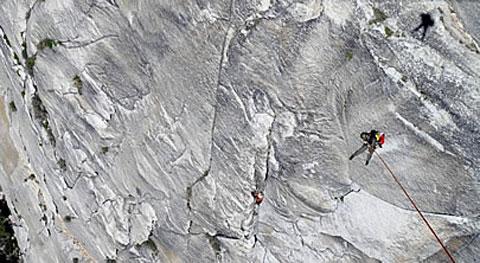Rangers at Yosemite National Park have seen plenty of visitors in perilous situations, but apparently even they were shocked when they saw the dire situation of a man stranded on a tiny ledge.
According to a park report,
Park dispatch received a cell phone call from climber Daniel Susman around 10 a.m. on Wednesday, July 15th, in which Susman reported that he’d become ledged-out while scrambling on a dome near Merced Lake and that he’d need assistance getting off the ledge. He said that he wasn’t in any immediate danger, but that he was unable to ascend or descend from his location.
Such situations aren't especially uncommon, but this visitor was apparently a master at understatement.
Upon flying past, rescue personnel were shocked to discover that Susman had downplayed his predicament. They found that he was standing on minuscule ledge, clinging to the rock on a nearly vertical wall approximately 800 feet above the valley floor. Susman’s position was deemed to be too tenuous to try to retrieve him directly by short haul.
The concern was that the buffeting winds from the aircraft might dislodge Susman from his stance before he could be made secure. The pilot, Richard Shatto, and the two spotters, Jeff Pirog and Boots Davenport, had a difficult time maintaining a steady hover with the aircraft due to gusting winds. Ranger Keith Lober was short-hauled into a location 50 feet above Susman’s perch where he power drilled three anchor bolts.
Ranger Eric Gabriel was then short-hauled to the anchor station. Lober lowered Gabriel down to Susman, who was then secured in a “screamer suit;” he and Gabriel were then short-hauled off the face.
Cell phone coverage in Yosemite backcountry is generally nonexistent. Susman was incredibly lucky, as the location where he became stuck was just high enough for the cell signal to peek over the surrounding rock faces and hit the Sentinel Dome repeater, the only repeater in that area of remote wilderness.
Incidentally, Susman had sustained and recovered from two short falls just before deciding to stop and request help.
Susman is reportedly on a long-distance hike and was passing through Yosemite when he decided to try the climb. He was free-climbing, with no "protection" (i.e. ropes or anchors.)
Although it's a lot better to avoid getting into such situations in the first place, once things start to go bad, know when to say when! This one had a successful ending because the visitor followed rule #2—and a lot of things came together at the right place and right time for his sake, including a highly-skilled pilot and SAR personnel.




Comments
Anonymous -
Thanks for your comment about climbing in Yosemite. You raised some interesting questions, so I made a call to the park and got a few more details on this specific situation. I'll amend the story slightly for clarification, as described below.
The man is making a long-distance hike on the Pacific Crest Trail, so he's in good condition and has some outdoor skills. He's done a little climbing in the eastern U.S. - but apparently nothing of the caliber of Yosemite. I'd note that the definition of a "climber" is a very subjective one!
This particular situation sounds like an "impulse" activity. The man left his pack for his long-distance hike at the base of a nearly vertical wall that is about 1,000 feet high, and was free climbing with no protection; he was wearing hiking boots.
The good news? After he was rescued, the man was described as being very subdued and grateful; the reality of his close call had apparently sunk it by the time he was safely on the ground.
Given the tricky winds described in the story, I'm very thankful this situation ended safely for everyone, including the pilot and the rescuers. Those flying conditions made this rescue even riskier than usual, and was another testimony to the skills of those involved.
All of us learn by experience, so I trust this was a lesson learned by this individual. Perhaps at least a few people who heard about this incident will also think twice before attempting something similar.